Recipes: Spiky meatball soup, braised leek with blue cheese crumb, Napoleon cake, Lady Marmalade melting moments
Many an Aussie kid who grew up in the 1970s and 1980s enjoyed this meatball soup ... and it’s so simple to prepare. Bonza!
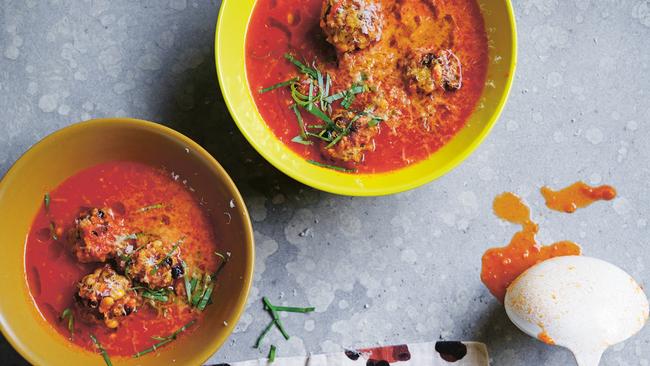
The inspiration for my new book The Joy of Better Cooking comes from the realisation that for many people, cooking is a “need to do” rather than something they enjoy.
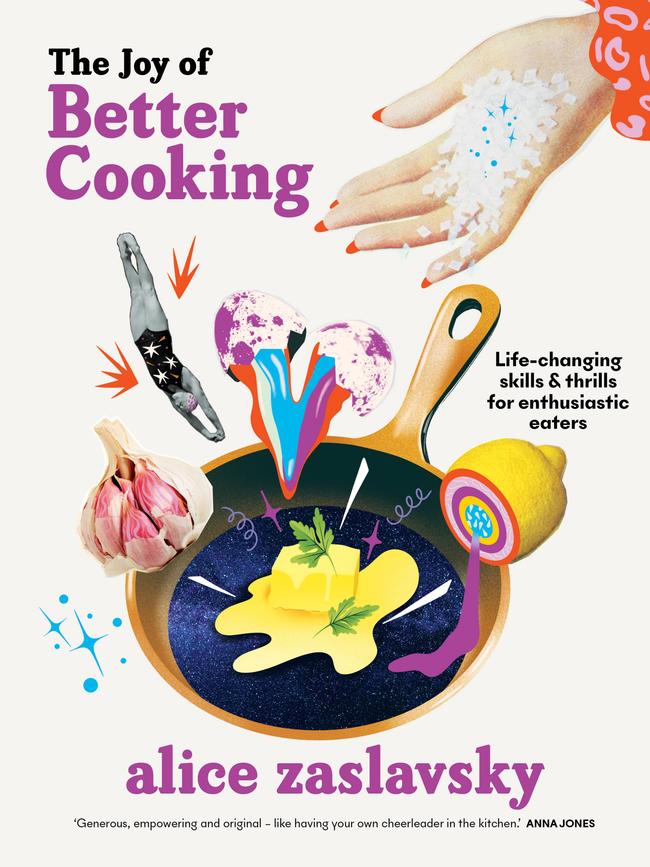
Each recipe here is designed to make cooking simpler and more enjoyable, whatever stage you’re at. Whether it’s reaching for a tin of tomatoes at the shops, or tapping into the alchemy of leeks and butter, you’ll be left with lifelong skills and shortcuts that’ll make kitchen time a joy.
It is my hope that the book will help people discover that the kitchen can be a place of connection, contentment and confidence.
Tune in with all of your senses: the feeling of water running through your fingers as you rinse ingredients under the tap; the aroma of something simmering in the pot; the colour-change of a sear … the look of delight in the eyes of those at your table when the plates drop. The silence that comes with satisfaction.
-
Spiky meatball tomato soup
Serves 4–6
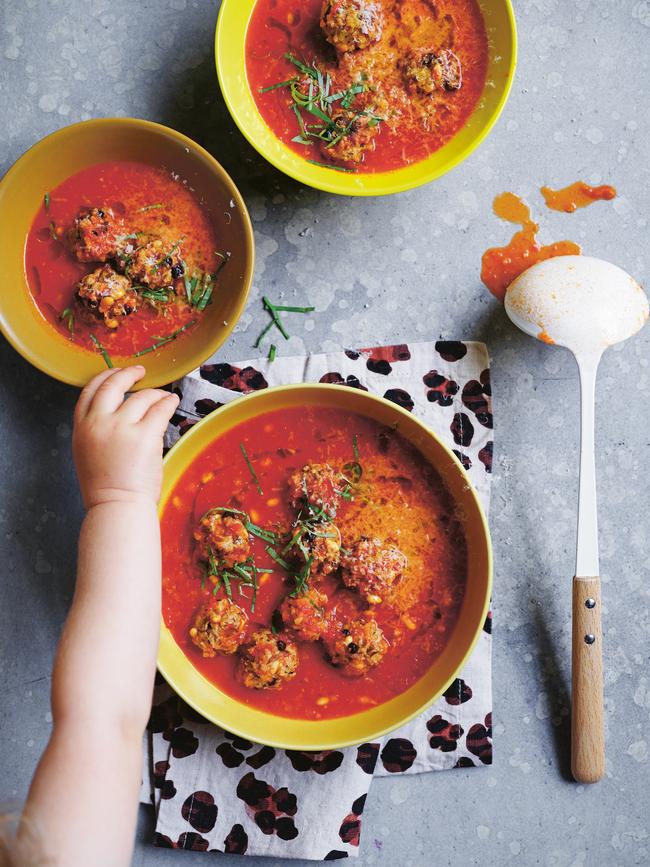
Many an Aussie kid who grew up in the 1970s and 1980s scored these meatballs cooked in tinned tomato soup, based on an old Dutch staple, on the regular.
The meatballs were made to look like spiky little creatures with the addition of long-grain rice and, once added to the soup, they’d cook and flavour the broth, springing and puffing like magical hedgehogs — or echidnas, to keep the Australiana theme going.
This tomato soup isn’t quite out of a tin, but still uses the best processed tomatoes you can find, and the meatballs are made with store-bought sausages, spiked with extra fun bits like currants and pine nuts, making them practically a polpette.
It’s a great lesson in letting other people do the hard work for you flavour-wise, so it’s still a super simple soup to prepare, and the taste is just bonza (‘better than good’ in Aussie slang) … or belissima if you’re that way inclined.
Ingredients
2 tablespoons olive oil
1 red onion, diced
1 red capsicum (pepper), diced
4 garlic cloves, roughly chopped
1/2 cup (125ml) white wine
1/2 teaspoon sweet or smoked paprika (whatever’s in your pantry)
2 tablespoons tomato paste (concentrated puree)
400g (14 oz) tinned good-quality whole peeled or chopped tomatoes
2 cups (500ml) chicken or vegetable stock (no added salt)
1 teaspoon sugar (any kind will do; just add less if the crystals are finer)
1 bouquet garni, made with basil stalks, a stem of dried Greek oregano and 2 bay leaves
1/2 teaspoon freshly cracked black pepper
Meatballs (makes about 35)
500g (1lb 2 oz) pork and fennel sausages (see Subs, page 75)
1/2 cup (50g) finely grated parmesan
1/2 cup (80g) pine nuts
1/4 cup (40g) currants
1/4 cup (50g) long-grain white rice 1/4 cup chopped parsley
To serve
Finely grated parmesan thinly sliced basil, to garnish
A drizzle of the very best olive oil
Method
In a large heavy-based saucepan, heat the olive oil and saute the onion, capsicum and garlic for a minute or two until the mixture starts to sizzle.
Pop on the lid and leave to sweat over medium–low heat, stirring occasionally, for 5–8 minutes, until the onion has softened.
Pour the wine into the pan, scraping all the yummy flavoursome bits of caramelisation off the bottom to deglaze the pan. Stir in the paprika and tomato paste and saute for another 2 minutes.
Add the tinned tomatoes, then pour some fresh water into the tin, slosh it around to clean out the dregs and add that to the pan, too, along with another tin’s worth of water.
Stir in the stock, sugar and another 4 cups (1 litre) water. Drop in the bouquet garni and bring to the boil, skimming off any froth that rises to the surface.
At this point, fish out the bouquet garni. Get your stick blender out and give the soup a bit of a zhuzh. You can leave a few chunks in, or puree until smooth.
Meanwhile, make a start on the meatballs. Have a little bowl of water nearby.
Slip the sausage meat out of the casings into a bowl, and combine with the remaining meatball ingredients. Wet your palms before shaping the mixture into balls the size of walnuts; they’ll expand to golf-ball size as they cook.
Some sausages can be fairly salty, so check the seasoning of one of the meatballs by poaching it in the soup for 5 minutes, then taste and add extra salt only if needed.
Pop all the meatballs into the soup and simmer for 35–40 minutes, or until the echidnas emerge out of their burrows and the oil rises to the top, adding more stock or water if needed.
Serve garnished with a grating of parmesan, some thinly sliced basil and a drizzle of your best olive oil.
-
Braised leek with blue cheese crumb
Serves 4-6
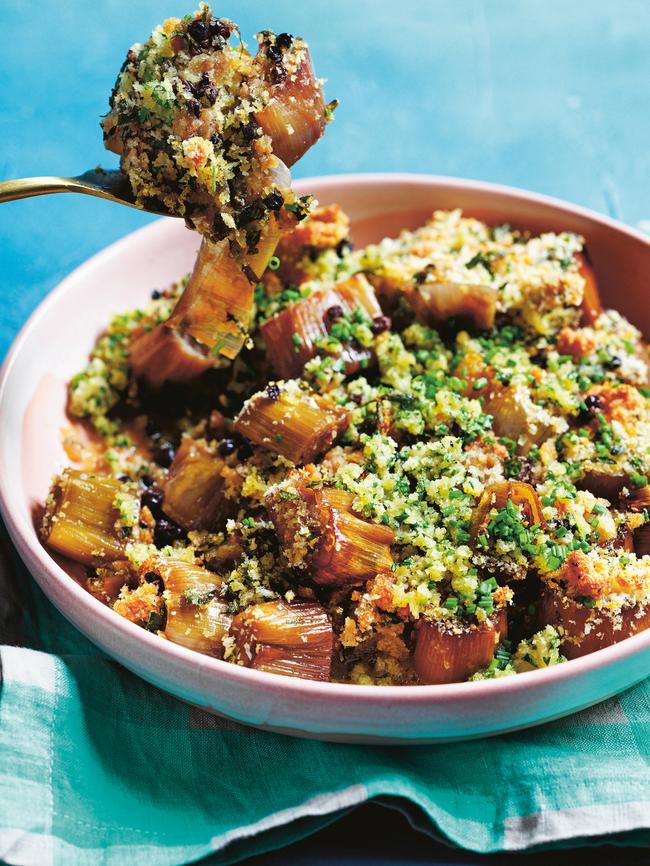
This feels like a super retro combo … because it IS!
Leek, with its pungency and sweetness, really loves a bit of crumbly blue cheese action, and the sweet currants are like little pops of syrupy surprise, capped off with a crispy panko crumb.
Here, most of the prep time is spent swanning past the oven, wafting the aromas towards your nostrils and rubbing your hands together with glee.
The flavours will only intensify overnight, so it’s perfect for a lazy Saturday bake, with a luscious Sunday lunch finish.
Bake the leek the day before, and the next day finish it off by adding the crumb, covering with foil and popping into a preheated 180°C (350°F) oven for 10 minutes, then removing the foil and exposing the crumb to the elements for the last 20 minutes to get some burnish.
Leftovers will happily languish in the fridge for up to a week, so you really can’t go wrong with this dish. It will go gloriously as a side with fish or chicken, or stand on its own as a vego main.
Ingredients
3 leeks, about 750g (1lb 10 oz) in total
1 cup (250ml) chicken or vegetable stock
1 cup (250ml) decent white wine (if you can’t drink it, don’t cook with it)
½ cup (75g) currants
10 thyme sprigs
100g (3½ oz) butter
2 tablespoons snipped chives
Blue cheese crumb
100g (3½ oz) of your favourite blue cheese, crumbled
¾ cup (45 g) panko breadcrumbs
½ cup finely chopped parsley
½ teaspoon garlic powder (optional, but excellent)
2 tablespoons olive oil
Method
Preheat the oven to 180°C (350°F).
Meanwhile, remove the green tops from the leeks (see Waste knot, below) and cut the pale parts into 1.5 cm (5/8 inch) chubby discs. Soak the leeks in a salad spinner or bowl filled with cold water to get rid of any grit, then drain and spin, or wash them really well under the tap.
Snuggle the leek, cut side up, in a 20x30 cm (8x12 inch) baking dish. Add the stock, wine, currants and thyme. Dab the butter over the top, cover with foil and bake for 2 hours.
Combine the crumb ingredients in a bowl by stirring vigorously together with a spatula or wooden spoon. (You could also use your hands, if you’re a fan of finger-lickin-blue — but no more touching the mixture once any licking has ensued, of course!) You want to end up with a nice chunky crumb.
At the 2-hour mark, remove the dish from the oven. Flick off the foil, fish out the thyme stalks and submerge the currants into the braising juices. Sprinkle with the crumb and bake, uncovered, for a further 30 minutes, until the top is golden and the juices have reduced to a syrupy consistency.
Serve in the baking dish or a serving bowl, drizzled with the juices and sprinkled with snipped chives, salt flakes and freshly ground black pepper.
Waste knot
Keep the green ends of the leek for the freezer. Just remember to wash them well first. It may require some elbow grease and a good soak, but the bonus flavour you’ll get into your stocks and soups is way worth the effort.
-
Conquering Napoleon
Serves 8-12
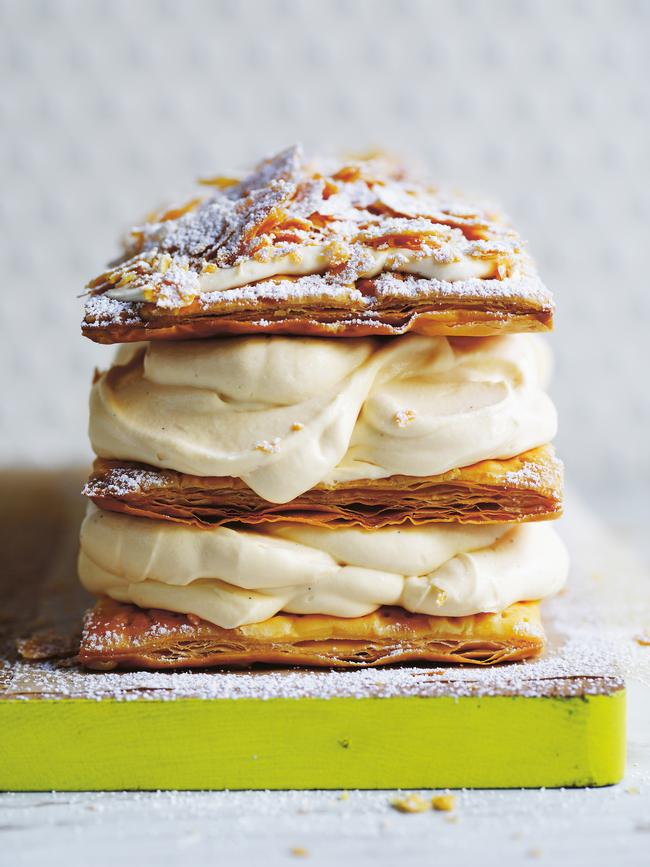
Every family has ‘a cake’, and Napoleon is ours. It’s the Russian version of a French mille-feuille (‘one thousand layers’) or the Aussie vanilla slice, which makes sense, because the many many layers of cream and pastry in a traditional Napoleon are a bit like a Babushka doll crossed with a mille-feuille, and just as complex to make.
Of course, by now you’ll know that my mum is the shortcut queen, so hers is the cheat’s version — because ain’t nobody got time for 18 layers. Instead, she blends the best bits — flaky puff pastry and a custardy crème pâtissière — with a sprinkling of icing sugar and spare pastry flakes to finish (because she also doesn’t believe in waste).
Speaking of blending and shortcuts, instead of making crème pâtissière from scratch, Mum simply blends store-bought crème caramels with cream to help set it, and for bonus flavour, which I discovered only very recently.
You could say this is ‘an old family recipe’, but really, it’s more of ‘an old family philosophy’: find the shortcuts to success, leave nothing behind, and always say ‘yes’ to a second piece of Napoleon.
Ingredients
2 square sheets of butter puff pastry, cut in half, or 1 x 375g (13 oz) roll of butter puff pastry, cut into thirds
600ml (21 fl oz) thickened (whipping) cream
2x150g (5½ oz) store-bought crème caramels (see Tips)
1 teaspoon vanilla bean paste
A pinch of salt flakes (optional)
Icing (confectioners’) sugar, for dusting
Method
Preheat the oven to 200°C (400°F). Line one or two baking trays with baking paper, and have another baking tray or trays at the ready.
Place the pastry pieces on the lined baking trays, without overlapping, then poke the pastry all over with a fork. Top with another sheet of baking paper and place another baking tray on top. The pastry will want to puff up, but the trays will keep it flat, which is what you’re after here.
Bake on the middle rack of the oven for 30 minutes. Remove the top baking tray and baking paper sheet. Flip the pastry over and bake for another 10 minutes, or until the pastry is very golden (bordering on ‘lightly browned’), and evenly cooked all the way through. Cool completely on a wire rack.
Meanwhile, whip the cream until soft peaks form, then add the crème caramels, vanilla paste and salt flakes, if using. Whip again until stiff.
Use a serrated knife to carefully trim the edges of the cooled pastry; reserve these for the top of the Napoleon. If you used square pastry sheets, leave three intact and crumble the fourth into flakes (or embrace a four-layered Napoleon and use less cream on each layer).
Place a pastry piece on a serving plate. Spoon just under half of the pastry cream on top, before topping with another layer of pastry and another half of the pastry cream. Add the last layer of pastry, then top with the remaining pastry cream and any broken-up pastry flakes, if you’ve ended up with any. Dust liberally with icing sugar.
Leave in the fridge overnight to soften for a traditional Napoleon, or serve immediately for more of a mille-feuille vibe. Both will make you feel a million bucks at the table!
-
Lady Marmalade melting moments
Makes about 25 filled sandwiched biscuits
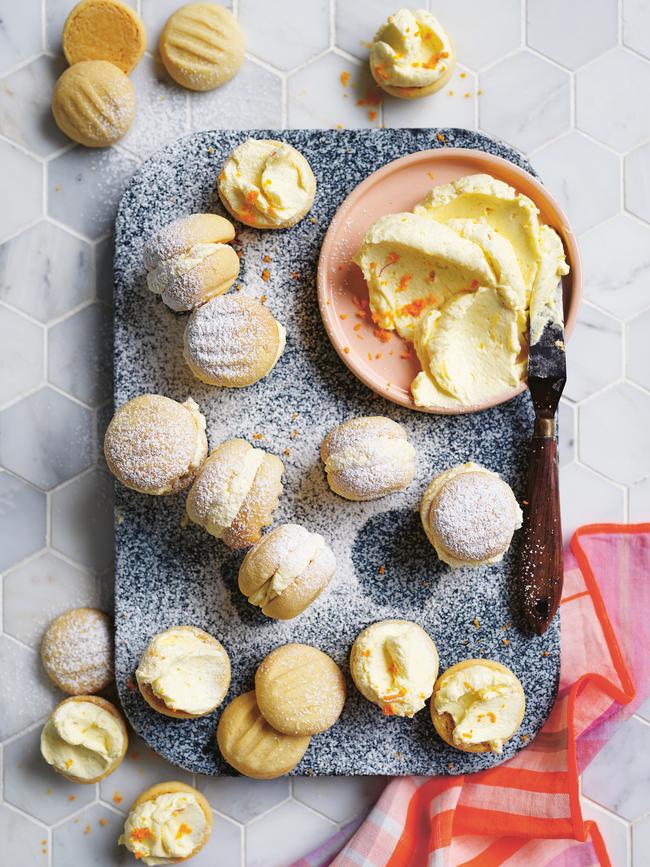
You know that version of the song ‘Lady Marmalade’, where Christina Aguilera pumps out that EPIC note as she begins her verse? What a MOMENT, right!? That’s what these melting moments remind me of.
The slightly bitter tang of the marmalade in the buttercream is enough to splice through the richness of the biscuit and filling, and as it melts on your tongue, you’ll find yourself having a moment, too.
I’ve adopted the custard powder of the classically Aussie yo-yo biscuit, because I like the colour and flavour it provides. Most melting moments recipes use cornflour (cornstarch) — either of these additions stop the flour and fat binding too tightly, which means the biscuit will, quite literally, melt in your mouth.
Ingredients
1/3 cup (40g) icing (confectioners’) sugar
250g (9 oz) unsalted butter, softened
1½ cups (225g) plain (all-purpose) flour, plus extra for dusting (see Subs)
½ cup (75g) custard powder (see Subs)
1 teaspoon baking powder
¼ teaspoon salt flakes
Marmalade buttercream
100g (3½ oz) unsalted butter, softened
2/3 cup (85g) icing (confectioners’) sugar, plus extra for dusting
Zest and juice of ½ orange
1 heaped tablespoon orange marmalade
Method
Line two light-coloured baking trays (ideally biscuit trays) with baking paper.
If your icing sugar is lumpy, pop it into a food processor and blitz, or into a zip-lock bag and mash with a rolling pin.
Using a stand mixer with the paddle attachment, beat the softened butter until uniformly soft, then add the icing sugar and beat until the mixture is pale and creamy (more is more here).
Sift together the flour, custard powder and baking powder. Add to the butter mixture, along with the salt, and mix with a wooden spoon until just combined.
Use a teaspoon measure dusted with a smidge of flour to scoop out 2 level teaspoons (5g) of the mixture, rolling into walnut-sized balls between your hands. If your hands are hot, pat a little flour onto them to stop the mixture sticking. Evenly space the balls out on the baking trays. Don’t worry if they’re a bit mangy; you can always smooth them out once chilled.
Pop the trays in the fridge to chill for 15 minutes, or even overnight.
When ready to bake, preheat the oven to 150°C (300°F). Use a floured fork to press each dough ball into a 2cm (¾ inch) disc.
Bake for 15–18 minutes, until the biscuits are set enough to be dislodged with a gentle prod, are custard-yellow in colour and the bottom is still blonde. Allow to cool for 10 minutes, then cool completely on a wire rack before filling.
Make your buttercream in the stand mixer by creaming the butter and icing sugar together until super pale. Add the orange zest, juice and marmalade and beat until incorporated.
To fill the biscuits, either transfer the buttercream to a piping bag and squeeze it over half the biscuits, or spread a teaspoon of filling over them. Pop the unfilled biscuits on top of the filled ones like hats, squashing ever so slightly to more evenly distribute the filling.
Give the whole lot one last dusting of icing sugar as a final flourish.
The biscuits will keep in an airtight container in a cool place for up to 5 days. They can also be frozen (filled or unfilled) for up to 3 months; thaw for at least 30 minutes before serving.
-
What brings you the most joy in the kitchen? The best five answers emailed to alice@aliceinframes.com will win a copy of Alice Zaslavsky’s new cookbook.



To join the conversation, please log in. Don't have an account? Register
Join the conversation, you are commenting as Logout